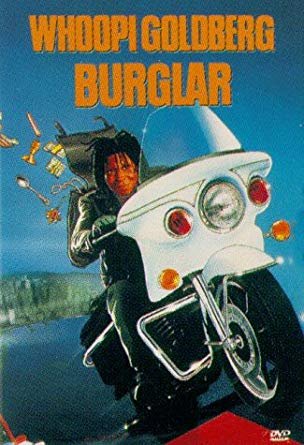
Burglar (1987)
Burglar has some importance for me. It’s a 1980s movie, one of Whoopi Goldberg’s assorted comedy-esque films, with the general guideline of the 1980s movie ratings and what could and couldn’t be said, you could still show people smoking weed, occasional frontal nudity if it was only breasts, and F-bombs were plentiful. A black woman could be the lead in a movie without it raising too many eyebrows, even if she was the only POC in the entire movie, and played a criminal with a facial tattoo that implied she was either raped in prison, murdered a prison guard, or both (though it’s never addressed).
This, however, meant nothing to me when I first saw it, because I was 9 years old in 1987 and didn’t get half of the things that were being talked about. All I understood at the time was that Whoopi’s character, Bernie, was accused of killing someone, but didn’t do it, and was trying to track down the person who did so. And it had something to do with Johnny Carson, and she catches the bad guy in the end.
It wasn’t until years later that it worked its way into my “sick day” movie rotation that I started to get more of the plot, and understand what was being talked about, and then when I finally did research on it to write an essay on it to nose-thumb at my priggish first advisor at grad school, who wanted me to only consume the works of Cormac McCarthy and avoid anything meant for a wider audience. I went looking for an easy paper, I instead found something else.
Editing is common, especially when a book is adapted to film. Adapted from Lawrence Block’s The Burglar in the Closet, the film changes the setting from New York’s Upper East Side to San Francisco, and the lead character Bernard Rhodenbarr, a white, Jewish man, into Bernice Rhodenbarr, a black woman. Critics and the author did not approve. However, that isn’t what I’m going into. Rather, I’m going into what else was edited and filtered out, particularly regarding the times.
The 1980s were not, obviously, a good time for the LGBTIQAP+ community, largely because they were only generally known as the Gay and Lesbian community and the specter of AIDS was prevalent, all of the other letters might have been known of, but weren’t spoken of, and definitely not shown in popular media. When they were, they were shown in strict stereotypes, or shown as depraved or self-loathing. In the case of The Burglar in the Closet, one LGBT character is Carolyn Kaiser, Bernie’s “lesbian soulmate”, the friend who knows of his thievery and cooperates, and by sole virtue of her homosexuality is the only woman Bernie doesn’t sleep with in the series. In Burglar, Carolyn is erased and edited into Carl Helfer, Bernie’s supportive friend, played by Bobcat Goldthwait, who played the “Bobcat Goldthwait” type of the 1980s, and was definitely straight given the character is shown hitting on multiple women during a bar crawl.
The murder victim is altered as well, from a dentist’s ex-wife in the book to a philandering ex-husband in the film. While the murder-mystery follows the general beats of a mystery novel (kill or alibi the suspects until the random character from Act I is revealed as the killer), it’s the editing of the victim that still comes to mind when I think of the portrayal of LGBT characters in the 1980s. The victim, Christopher, is stabbed to death with a dental elevator, and during Bernie’s investigation is implied to be bisexual, and other than being murdered, isn’t mourned or grieved save by one of his occasional hook-ups that provides Bernie with her only real leads.
The killer, Carson, is revealed to either be a self-loathing homosexual, or a self-loathing bisexual, who brutally murdered Christopher for…? Jealousy, and nothing more. Not greed, or wanting to not be left out of a counterfeiting scheme, or potential blackmail regarding Carson’s illicit affair, just jealousy that his occasional lover was taking someone different home every night, and then proceeds to murder two other people simply for the sake of... why? Again, it wasn’t a good adaptation, but it was a plotline that was inserted into the screenplay for the sake of providing a killer, so they went with a Depraved Homosexual and a Bury Your Gays.
What effect does this have in the 1980s for young LGBT kids? If you’re not straight, you’ll either go on a killing spree, or be impaled by dental equipment. This wasn’t the first example of mainstream film in the 1980s killing the LGBT character, nor was it the last, but it was the first time I had seen this, keeping my feelings and attractions to myself because it was another reason of what society thought of me.
However, that wasn’t the only movie with an LGBT character that I saw in 1987.
Posted from my blog with SteemPress : https://vaughndemont.com/2018/07/02/1987-and-lgbt-character-portrayal-part-1-burglar/
This post has been voted by the lgbt-party group and curation trail. The point of this group is to bring real community to steem, and to fight for our rights and recognition. This includes rewarding the typical blog-style posts, questions, and helpful comments.
Come join us on discord! : https://discord.gg/RWemhCv
This post has been voted by the lgbt-party group and curation trail. The point of this group is to bring real community to steem, and to fight for our rights and recognition. This includes rewarding the typical blog-style posts, questions, and helpful comments.
Come join us on discord! : https://discord.gg/RWemhCv